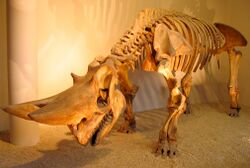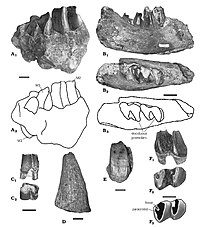Biology:Arsinoitherium
| Arsinoitherium | |
|---|---|

| |
| A. zitteli cast, Natural History Museum, London | |
| Scientific classification | |
| Domain: | Eukaryota |
| Kingdom: | Animalia |
| Phylum: | Chordata |
| Class: | Mammalia |
| Order: | †Embrithopoda |
| Family: | †Arsinoitheriidae |
| Genus: | †Arsinoitherium Beadnell 1902 |
| Type species | |
| Arsinoitherium zitteli Beadnell, 1902
| |
| Species | |
| |
Arsinoitherium is an extinct genus of paenungulate mammals belonging to the extinct order Embrithopoda. It is related to elephants, sirenians, and hyraxes. Arsinoitheres were superficially rhinoceros-like herbivores that lived during the Late Eocene and the Early Oligocene of North Africa from 36 to 30 million years ago, in areas of tropical rainforest and at the margin of mangrove swamps. A species described in 2004, A. giganteum, lived in Ethiopia about 27 million years ago.
Taxonomy
The best-known (and first-described) species is A. zitteli. Another species, A. giganteum, was discovered in the Ethiopian highlands of Chilga in 2003. The fossil teeth, far larger than those of A. zitteli, date to around 28–27 million years ago.[1] While the Fayum Oasis is the only site where complete skeletons of Arsinoitherium fossils were recovered, arsinoitheriids have been found in southeastern Europe, including Crivadiatherium from Romania, and Hypsamasia and Palaeoamasia from Turkey.
The generic name Arsinoitherium comes from Pharaoh Arsinoe I (after whom the Faiyum Oasis, the region in which the first fossils were found, was called during the Ptolemaic Kingdom), and the Ancient Greek: theríon "beast". The species epithet of the type species, A. zitteli, was given to it in honor of the eminent German paleontologist Karl Alfred Ritter von Zittel, regarded by some as the pioneer of paleontology in Egypt.[2]
Description
Adults of the species A. zitteli stood around 1.75 m (5.7 ft) tall at the shoulders and 3 m (9.8 ft) in length.[3][4] It measured 2.5 tons, only slightly smaller than the modern white rhino and due to the similar features and sizes, Arsinoitherium is commonly thought to be an extinct rhinoceros species, but it is not closely related to rhinos; instead, their closest extant relatives are elephants and manatees. They were massive, slow-moving animals with forelimbs adapted for pulling strongly backward rather than swinging forward, a feature typical of animals that punt themselves through shallow water or walk on soft, sticky ground. Fossils are found in sediments deposited in coastal swamps and warm, humid, heavily-vegetated lowland forests across what is now Africa and Arabia.[5] The most noticeable features of Arsinoitherium were a pair of enormous horns above the nose and a second pair of tiny knob-like horns over the eyes. These were structurally similar to the horns of modern bovids.[6][7] While reconstructions usually show them as similar to the ossicones of giraffes, in life each bony core may have been covered, like the horn cores of bovids, with a large horn of keratin.[8] Both males and females had horns. While some investigators have described a larger and a smaller species from the same site, others have identified the difference in body and tooth size as sexual dimorphism.[9] The skeleton is robust and the limbs were columnar, similar to those of elephants; the hips were also elephant-like,[3] and arsinotheres were not built to run. Arsinoitherium had a full complement of 44 teeth, which is the primitive state of placental mammalian dentition. However, the genus had a unique and highly specialized way of chewing, shifting the jaw joint to produce constant pressure along its continuous row of teeth; it has been reconstructed as a highly selective browser.[10]
Distribution
Fossils of Arsinoitherium have been found in:[11]
- Eocene
- Aydim Formation, Oman
- Idam Unit Formation, Libya
- Djebel Chambi, Tunisia
- Oligocene
- Malembe, Angola
- Jebel Qatrani Formation, Egypt
- Chilga formation, Ethiopia
- Erageleit Formation, Kenya
- Ashawq Formation, Oman
- Shumaysi Formation, Saudi Arabia
References
- ↑ Sanders, W.J., Kappelman, J., and Rasmussen, D.T. 2004. New large−bodied mammals from the late Oligocene site of Chilga, Ethiopia. Acta Palaeontologica Polonica 49 (3): 365–392.[1].
- ↑ Beadnell, H.G.C. (1902). "A preliminary note on Arsinoitherium zitteli, Beadnell, from the Upper Eocene strata of Egypt". Public Works Ministry, National Printing Department (Cairo): 1–4. https://archive.org/details/preliminarynoteo00bead.
- ↑ 3.0 3.1 Andrews, C.W. (1906). A descriptive catalogue of the Tertiary Vertebrata of the Fayûm. British Museum, London. Taylor and Francis. pp. 324. https://www.biodiversitylibrary.org/bibliography/55134#/summary.
- ↑ Mondéjar-Fernández (2008). "El género Arsinoitherium: catálogo de la colección inédita del Muséum d'Histoire Naturelle de París y el problema del número de especies" (in Spanish). Palaeontologica Nova SEPAZ (8): 292–304. https://www.academia.edu/1470135.
- ↑ Al-Sayigh, Abdul Razak; Nasir, Sobhi; Schulp, Anne S.; Stevens, Nancy J. (2008-03-01). "The first described Arsinoitherium from the upper Eocene Aydim Formation of Oman: Biogeographic implications" (in en). Palaeoworld 17 (1): 41–46. doi:10.1016/j.palwor.2007.07.005. ISSN 1871-174X. https://www.sciencedirect.com/science/article/pii/S1871174X07000285.
- ↑ Andrews, C. W. (1906). A descriptive catalogue of the Tertiary Vertebrata of the Fayum. Publ. Brit. Mus. Nat. Hist. Land. XXXVII.
- ↑ Anonymous. (1903). A New Egyptian Mammal (Arsinoitherium) from the Fayûm. (1903). Geological Magazine, 10(12), 529-532.
- ↑ Turner, Anton, Alan, Mauricio (2007). Evolving Eden: An Illustrated Guide to the Evolution of the African Large-Mammal Fauna. Columbia University Press. ISBN 978-0231119450.
- ↑ Sanders, W. J., Kappelman, J., & Rasmussen, D. T. (2004). "New large-bodied mammals from the late Oligocene site of Chilga, Ethiopia.". Acta Palaeontologica Polonica 49 (3).
- ↑ Court, Nicholas (1992-02-01). "A unique form of dental bilophodonty and a functional interpretation of peculiarities in the masticatory system of Arsinoitherium (mammalia, Embrithopoda)". Historical Biology 6 (2): 91–111. doi:10.1080/10292389209380421. ISSN 0891-2963. Bibcode: 1992HBio....6...91C. https://doi.org/10.1080/10292389209380421.
- ↑ Arsinoitherium at Fossilworks.org
External links
- New fossils from Ethiopia open a window on Africa's 'missing years'
- Arsinoitherium fact file on BBC Science & Nature: Prehistoric Life
- Description of Arsinoitherium zitteli from upper Eocene strata in Egypt
- Vincent L. Morgan and Spencer G. Lucas (2002). "Notes From Diary––Fayum Trip, 1907" (PDF). Bulletin 22. Albuquerque: New Mexico Museum of Natural History and Science. https://www.scribd.com/doc/13199895/Notes-From-DiaryFayum-Trip-1907-Walter-Granger-Bulletin-22-2002-NMMNH.
Wikidata ☰ Q131720 entry
 |




